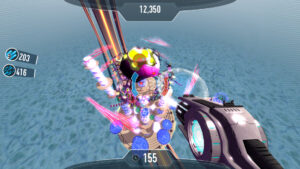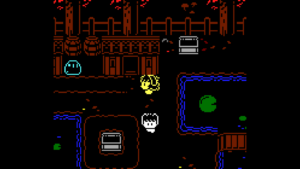Drunken Robot Pornography
 April Fools Day has come and gone for the year. I’ve been wanting to start up blogging again after the month’s rest, regarding it as a sort of New Month’s resolution for the year’s dawn, but chose to skip the day itself due to the poisonous expectations the day brings. Entirely by coincidence, however, some comments online recently inspired me to give a second look at a game that apparently has its origins in an April Fools Day joke. As much as I detest the holiday, this is a fine way for games to be born, granting designers the freedom to be audacious they really should be feeling all year round.
April Fools Day has come and gone for the year. I’ve been wanting to start up blogging again after the month’s rest, regarding it as a sort of New Month’s resolution for the year’s dawn, but chose to skip the day itself due to the poisonous expectations the day brings. Entirely by coincidence, however, some comments online recently inspired me to give a second look at a game that apparently has its origins in an April Fools Day joke. As much as I detest the holiday, this is a fine way for games to be born, granting designers the freedom to be audacious they really should be feeling all year round.
Drunken Robot Pornography is a 2014 release by Dejobaan, the same indie outfit that produced the BASE-jumping game AaaaaAAaaaAAAaaAAAAaAAAAA!!!, as well as The Wonderful End of the World, one of the few blatant Katamari imitations on PC. It’s an abstractish first-person shooter consisting mainly of fighting huge bosses while poinging around on jump pads. There are levels with other goals, like collecting stuff or just shooting at massed drones to reach a target score, but it’s the battles against the Titans, heavily-armed radially-symmetric robots that sit in place and rotate, that form the game’s focus. Sometimes all you have to do in a level is defeat a single Titan. Regardless of a level’s goal, it has to be done within a time limit of just a few minutes, tight enough to force reckless behavior, and thereby excuse it.
It’s got a similar sense of humor to other Dejobaan games: breezy wackiness tinged with apocalyptic desperation. The player character, Reuben Matsumoto, is comically irresponsible, essentially only fighting the robots destroying the metropolitan Boston area to avoid personal blame, probably hoping he can have the whole thing cleared up before anyone notices. “Reuben, do you think the Titans have souls?” queries his intelligent flight suit at one point, with exaggerated care; Reuben brushes him off with a weary “I dunno. Probably.”
But the main joke is in the gameplay. See, the Titans are a sort of boss usually seen in danmaku shooters: the kind where each weapon has its own hit box, and has to be destroyed individually. Except that bosses of this sort usually require a whole bunch of concerted fire at each piece to destroy it, and that’s not the case here. Weapons just sort of flake off, shed like autumn leaves at the barest touch. They compensate for this by having lots and lots of weapons. Destroying them feels less like blowing things up in a typical shooter than carving or shaving them off with strokes from your gun, paring off layer after layer of lethal ordnance to expose the fragile core. Their entire design is a laughable mismatch between power and vulnerability, and it’s something of a revelation that this makes for not only a viable game but, once you’re past the first dozen or so levels, actually a very hard one.
Hard enough that I don’t know if I’m going to be able to finish it. I think I’m about halfway to the end now, and I keep hitting walls.
 Comments(0)
Comments(0)